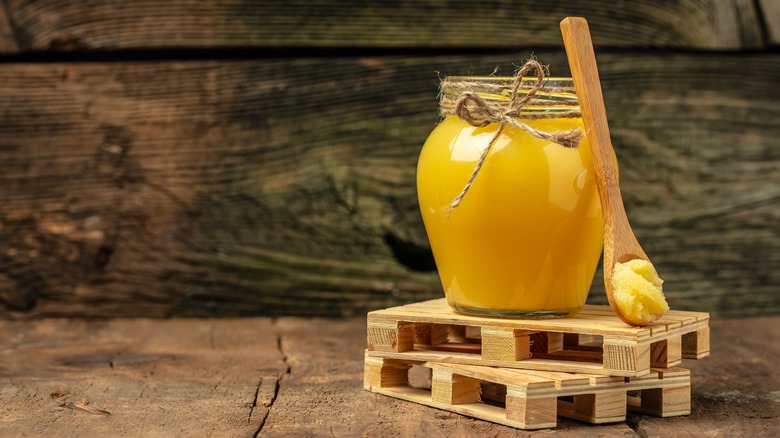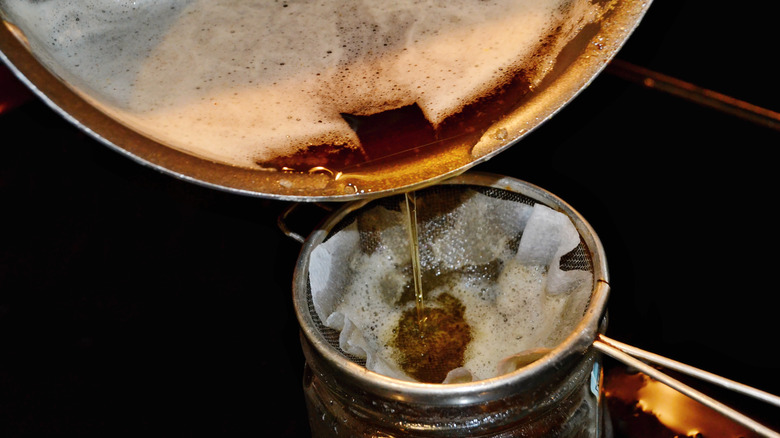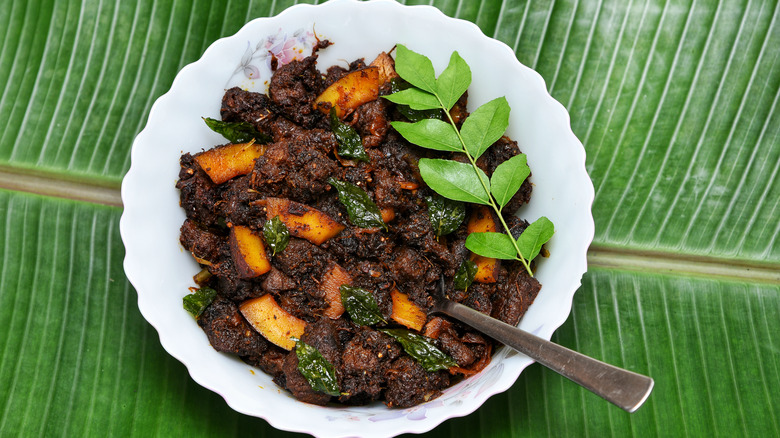Amplify The Flavor Of Ghee With This Basic Cooking Technique
Ghee can be a mystery to Western-style kitchens and cooks, but it definitely shouldn't be. This clear butterfat stands in for traditional butter in interesting ways, transforming ordinary dishes while also carrying the mystique of its origins. Ancient literary references in the Sanskrit language of India refer to ghee as "fit for the gods," and it even permeates Hindu mythology, according to the Washington Post. Tales handed down for generations attribute the creation of ghee to the lord Prajapati, whose children sprang forth as he poured ghee into fire.
Though ghee-fueled fires still serve as blessings in Hindi marriages and funerals today, it has much more practical uses in modern kitchens. And it happens to carry a host of health benefits as well. WebMD notes that ghee contains antioxidants and healthy fats that aid in the absorption of important vitamins and minerals. It can also help reduce cholesterol levels and contribute to heart and cardiovascular health. Practitioners of Ayurvedic medicine advocate ghee for reducing inflammation and treating burns or swelling, and it's generally considered safe for those with mild or moderate lactose intolerances.
It's easy to think ghee is no different from basic clarified butter, but the differences are distinct once you understand the process involved in making each one. In fact, a single cooking technique is what turns clarified butter into ghee and remarkably amplifies the flavor.
The secret to perfect ghee
Ghee is a form of clarified butter, which essentially means that the water in traditional butter evaporates through a slow simmer and the milk solids separate from the fat, settling at the bottom of the pan, explains MasterClass. After removing the solids, the remaining pure butterfat is the prize. This clear liquid is now clarified butter, but an extra step turns it into ghee. It's all about timing.
Rather than immediately removing the white milk solids at the bottom of the pan, a person making ghee will leave them to simmer for longer. In the process, those once-white solids become "light golden brown." That's the magic moment in which a warm, nutty taste spreads throughout the liquid, infusing it with toasty flavor notes. The Pioneer Woman points out hints of butterscotch flavor and cautions not to burn the milk solids at the bottom of the pan.
In a YouTube demonstration on making ghee, Milhaan Home reveals that the simmering and separation process takes roughly 19 minutes on very low heat when using a pound of butter. Some sources recommend unsalted, butter but salted is acceptable, depending on taste preference. Strain into a clean jar using cheesecloth, paper towels, or a paper coffee filter, and store at room temperature.
Cooking with ghee
Now that you've made (or purchased) that coveted jar of ghee, let the kitchen magic begin. Cooking with ghee is a constant surprise, leading to innovative dishes and new family favorites. If trying your hand at Indian cooking, you'll find many recipes calling for ghee as a primary ingredient in dishes such as curries, dal-style lentils, samosas, spicy potatoes, and Indian-style desserts, per the Los Angeles Times. Since it has a higher smoke point than traditional butter, ghee works well for sauteing, stir-frying, or roasting vegetables and meats, and it's a perfect base or topping for popcorn, according to the Academy of Culinary Nutrition. In recipes such as butter chicken, try using ghee and coconut milk instead of traditional butter.
Master Class points out that ghee can be used to replace cooking and finishing oils such as olive oil, adding a unique nutty flavor to steamed vegetables, roti, or even baked goods. Spiced ghee imparts an entirely new dimension to foods, and it's easy to accomplish. The Foreign Fork recommends using an Instant Pot to infuse your ghee with the aromas and flavors of the "three C's": cumin, cardamom, and cinnamon. For authentic Niter Kibbeh spiced ghee from Ethiopia, you'll also add cloves, peppercorns, turmeric, and nutmeg, along with garlic, onion, and ginger. The resulting rich and flavorful ghee appears in traditional Ethiopian stews, explains The Curry Guy, but works equally well as a marinade or basted onto grilled chicken, meats, and vegetables.


